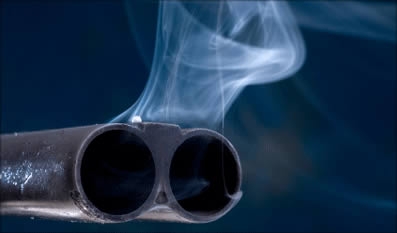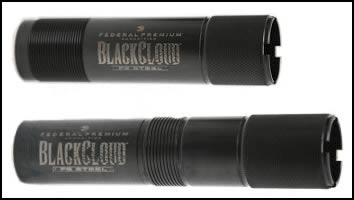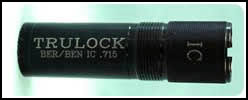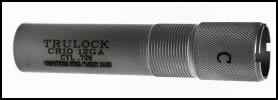Busting the Big Myth About Shotgun Chokes

We move through it, we shoot through it and we breathe it. It’s air. But it’s something most shooters never think about when they are competing in a sporting clays competition or even in practice. It is something we should consider when shooting above 3,000 feet. At 3,000 feet the air density is less than at sea level. At 5,000 to 6,000 feet it’s about 80% of what it is at sea level. It is that reduction of air density (altitude) that allows a shot string to stay tight longer than it would at sea level.
I live at 4,700 feet and do a good portion on my shooting at 4,000 to 5,000 feet or higher. I normally shoot most of my targets with skeet chokes, which still get good solid breaks out to 60 yards and beyond. When I was reviewing a new 28- gauge over-under choked skeet and skeet, a friend was surprised by the good breaks I was getting with ¾ ounce of 8½ shot. He was so impressed he wanted to pace off the distance. When he paced it off going out and again coming back, he found the distance to be 59 to 60 yards. Even the diminutive 28 gauge at 60 yards will crush a target when at altitude, which at the time was about 4,800 to 4,900 feet. When I lived at 5,120 feet in New Mexico and shot at altitudes up to 6,000 feet I broke many a target at 60 yards or more with the 28 gauge. There is no reason to shoot tight chokes at high altitudes because of the thinner density of air at altitude.

This revelation was brought home back in 1995 when attending a Holland & Holland shooting school to do a magazine article. The shooting facility near Vail, Colorado was located at 8,000 feet. None of the other shooters including myself ever gave the altitude any thought. We were shooting Federal 12-gauge International Paper load at 1,350 FPS with 24 grams of 8½ shot. It was a soft-shooting load because of the paper hull and the light shot load of 24 grams. When the shells were tested and compared, the Federal International load had less recoil than the standard 20 gauge 7/8 ounce load at 1,200 FPS.
Everything was normal throughout the second day and we shot somewhere between 400 to 500 rounds. When they took us to where there was a 60-yard crossing target everyone was getting their chokes out and were getting ready to change their chokes. The instructor told us not to change anything. If we had cylinder or skeet chokes in that we should leave them in. He wanted to make a point and he did. We all struggled with getting the right lead and hitting the distant crosser, but when we did, the target just disappeared. When it came to my turn I missed the first few targets until I found the correct lead. When I did, I was surprised by how hard the targets were hit. After we had all shot the station he explained what was going on and why it wasn’t necessary to use tighter chokes. It was a lesson that I never forgot.
I’ve shot with a lot of different shooters over the years and I was always interested in their methods and gear selection. The two following incidents happened at about 4,000 feet.
A few years ago I was shooting with a master-class shooter at a large zone shoot. He shot an automatic with a modified or improved modified choke and never changed it regardless the distance of the target. He was breaking many more targets than me, which is understandable. Finally, we came to another really tough station that was a true pair of chandelles, one left to right and the other right to left at about 60 yards or more. My partner shot first and only got one target out of the last pair of four pair. It was his worst station that day. I had skeet and skeet in and had decided to change to light modified (LM) and LM. I ended up with three pair out of four pair. I have always wondered what he would have gotten if he had opened up on the choke.
At another shoot not long ago, I was shooting with a friend who has a higher classification and we were shooting some distant incomers that showed their undersides to us and were sliding off to the left. He was shooting a modified choke and I was shooting a skeet choke. He missed two and I didn’t miss any. And he commented on the fact I was getting better breaks than he was. What it all gets down to is that I think most shooters tend to over choke for the targets they are shooting. They are shooting tighter chokes than needed to break the target and with the tighter choke missing the target completely because the shot string hasn’t opened up like it does at sea level and cooler weather.
Air density is less as we go up in altitude. Air density is affected by the air pressure, temperature and humidity. The density of the air is reduced by decreased air pressure, increased temperatures and increased moisture. A reduction in air density reduces the engine horsepower, reduces aerodynamic lift and reduces aerodynamic drag. It is the word drag that most concerns shotgunners. With air density being thinner, the shot string does not open as rapidly as it would if you were at a lower altitude or at sea level where air is denser nor does it loose speed as fast. But there are other factors as well.

Air temperature changes from summer to winter can cause air density variations up to 25%, with a similar change in your shot pattern. That means tighter patterns in hot and warm weather and more open patterns in cold and dry weather. The two main factors in shot pattern density are air temperature and altitude. In a given day, normal air temperature variations can be as high as 8% which affects your shot pattern 8%. The more humid the air is the lighter air density which can vary up to 2%. Air pressure variations can be as high as 4% in a day. So when you consider the air pressure in an area, the elevation at which you’re shooting, the humidity and the temperature, you can have a total variation of some 35-50% that will affect your pattern to the same degree. And we haven’t even considered air turbulence or the out of round shape of the shot when deformed at the moment of ignition of the powder in the shell.
People who shoot in the Midwest or farther east aren’t going to be concerned with this as much unless they go to some major shoots out west where they will more than likely be at a higher altitude. But at sea level you still should consider all the elements except of course altitude. With more people shooting one-ounce loads they might feel that they have to use tighter chokes. I would suggest that they try using the same one ounce load with 8½ size shot. It’ll give you about 70 more pellets than size 8 shot. The pattern density in a one-ounce load of 8.5 shot (480 pellets) will be better than a one ounce load of size 8 shot (409 pellets). The kill zone of the 8½ size shot will also be about 2-3 inches larger in diameter than the 8-size shot. The next time you’re at altitude at a shoot, try using a choke with less constriction than what you would normally use and see if you pick up a couple of extra targets that would have been otherwise lost.

One other thing that you should remember from all this is that you should pattern your your shotshells at the same temperature and weather conditions that you plan to shoot or hunt with them. As a shotshell patterned on a hot, humid and low-pressure day in summer will not perform the same on a high pressure cold and dry day hunting ducks in winter.
I don’t advocate bringing a calculator to a shoot and finding out what the different weather conditions are to find the absolute air density in order to make a choke selection. But I would think you should consider what the altitude is at the place where you’re shooting and consider that in your choke selection. I think you’ll find you can shoot a wider open choke and still get the same or better breaks and pick up a few additional targets as well. To date, no one has done a comprehensive study of all the factors mentioned in this article. But firms in the shooting industry have noticed changes in the shot patterns when testing ammo from the morning sessions while it is still cooler and having wider patterns to the tighter patterns found in the afternoon when the air temperatures are warmer.
Jerry Sinkovec is a freelance outdoor and travel writer/photographer who writes for over 45 different publications nationally and internationally. He is also the director of the Browning-endorsed Instinctive Target Interception Shotgun Shooting School headquartered in Idaho Falls, Idaho. You can contact Jerry Sinkovec by visiting his web site at http://www.itishooting.com.
Useful Resources:

Jerry Sinkovec is a freelance outdoor and travel writer/photographer who writes for over 45 different publications nationally and internationally. He is also the director of the Browning-endorsed Instinctive Target Interception Shotgun Shooting School headquartered in Idaho Falls, Idaho. You can contact Jerry Sinkovec by visiting his web site at http://www.itishooting.com.


Comments